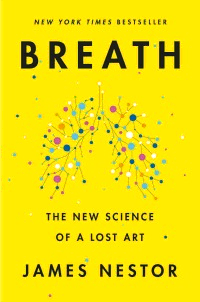Table Of ContentCover Page: i
Praise for BREATH Page: i
Also by James Nestor Page: i
Title Page Page: v
Copyright Page: v
Dedication Page: vii
Epigraph Page: ix
Contents Page: xi
Introduction Page: xiii
Part One: The Experiment Page: 1
One: The Worst Breathers in the Animal Kingdom Page: 3
Two: Mouthbreathing Page: 19
Part Two: The Lost Art and Science of Breathing Page: 35
Three: Nose Page: 37
Four: Exhale Page: 53
Five: Slow Page: 69
Six: Less Page: 85
Seven: Chew Page: 105
Part Three: Breathing+ Page: 137
Eight: More, on Occasion Page: 139
Nine: Hold It Page: 165
Ten: Fast, Slow, and Not at All Page: 185
Epilogue: A Last Gasp Page: 203
Acknowledgments Page: 215
Appendix: Breathing Methods Page: 219
Notes Page: 231
Index Page: 270
About the Author Page: 280
Description:A New York Times Bestseller A Washington Post Notable Nonfiction Book of 2020 Named a Best Book of 2020 by NPR “A fascinating scientific, cultural, spiritual and evolutionary history of the way humans breathe—and how we’ve all been doing it wrong for a long, long time.” —Elizabeth Gilbert, author of Big Magic and Eat Pray Love No matter what you eat, how much you exercise, how skinny or young or wise you are, none of it matters if you’re not breathing properly. There is nothing more essential to our health and well-being than breathing: take air in, let it out, repeat twenty-five thousand times a day. Yet, as a species, humans have lost the ability to breathe correctly, with grave consequences. Journalist James Nestor travels the world to figure out what went wrong and how to fix it. The answers aren’t found in pulmonology labs, as we might expect, but in the muddy digs of ancient burial sites, secret Soviet facilities, New Jersey choir schools, and the smoggy streets of São Paulo. Nestor tracks down men and women exploring the hidden science behind ancient breathing practices like Pranayama, Sudarshan Kriya, and Tummo and teams up with pulmonary tinkerers to scientifically test long-held beliefs about how we breathe. Modern research is showing us that making even slight adjustments to the way we inhale and exhale can jump-start athletic performance; rejuvenate internal organs; halt snoring, asthma, and autoimmune disease; and even straighten scoliotic spines. None of this should be possible, and yet it is. Drawing on thousands of years of medical texts and recent cutting-edge studies in pulmonology, psychology, biochemistry, and human physiology, Breath turns the conventional wisdom of what we thought we knew about our most basic biological function on its head. You will never breathe the same again.

